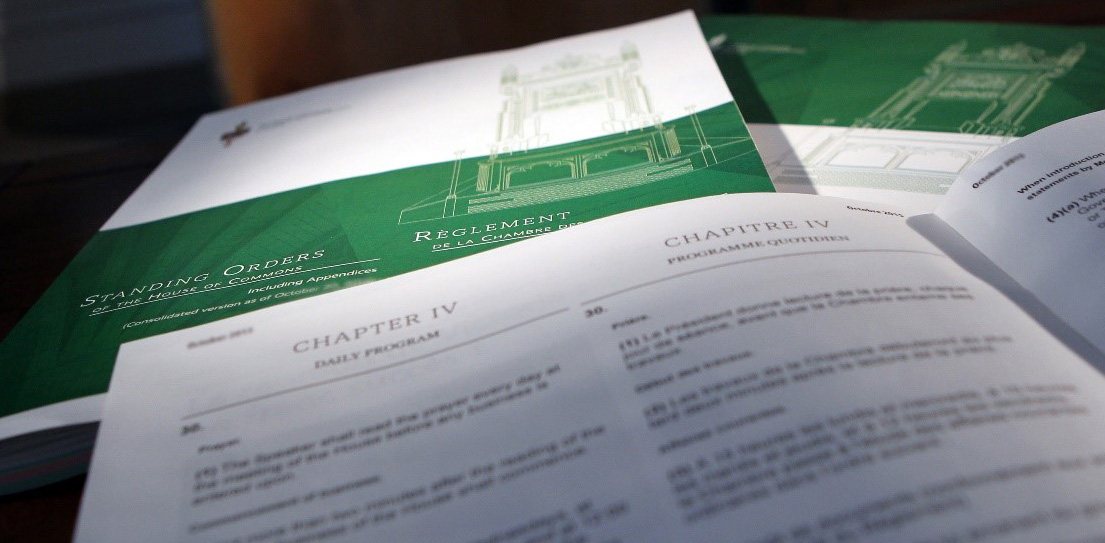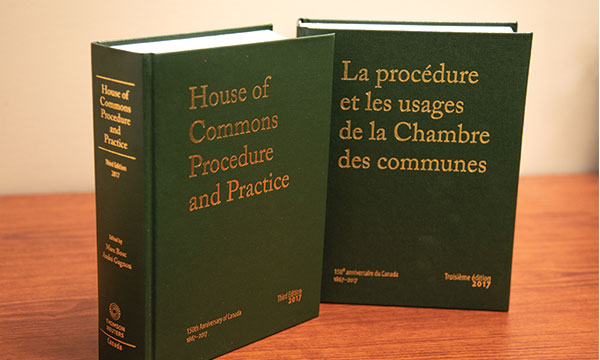Parliamentary Procedure
Summary
Parliamentary procedure is governed by a blend of constitutional provisions, statute law, Standing Orders, Speakers' rulings, and practices. The Constitution dictates essential elements like Parliament’s duration and quorum requirements. Statute laws, including the Canada Elections Act and Parliament of Canada Act, regulate electoral and operational processes.
Standing Orders are codified rules in relation to various aspects of parliamentary proceedings. These rules may be reviewed and amended by the Standing Committee on Procedure and House Affairs. Provisional, sessional, and special orders temporarily adjust or suspend procedural rules.
Speakers’ rulings resolve procedural concerns raised by members. Rulings serve as precedents while Speakers’ statements inform the House or clarify changes in procedure.
Unwritten practices supplement formal rules. Practices are periodically codified to reflect evolving norms. The authoritative resource, House of Commons Procedure and Practice, offers detailed procedural guidance and is available online.
Introduction
How the House of Commons goes about its work is regulated by rules and practices, that is procedure. It is a means of reaching decisions on when and how power shall be used and is intended to maintain a balance between the government’s need to get its business through the House and the opposition’s responsibility to debate that business without completely immobilizing the proceedings of the House.
The procedures of the House of Commons are founded on the Constitution, statute law, the Standing Orders of the House of Commons, Speakers’ rulings, and House practices and conventions.
The Constitution specifies the duration of a Parliament, that is five years, the quorum of 20 members (either in person or remotely) as the minimum needed to constitute a meeting of the House, and the requirement of the House “on its first assembling [after a general election to] proceed with all practicable Speed to elect One of its Members to be Speaker”. Statute law builds on the Constitution to form the legal and regulatory bases on which elections are conducted—the Canada Elections Act—and the House operates—the Parliament of Canada Act.
Standing Orders of the House of Commons

The Standing Orders are a collection of the current written rules adopted by the House to govern its proceedings. They detail the rules governing the legislative process, the Speaker’s role, the parliamentary calendar, the work of committees, and Private Members’ Business, among other topics. Appended to the Standing Orders are the Conflict of Interest Code for Members of the House of Commons and the Code of Conduct for Members of the House of Commons: Sexual Harassment Between Members.
Committee Review of the Standing Orders
The Standing Committee on Procedure and House Affairs is empowered to review the Standing Orders, procedure and practice of the House of Commons and its committees. The Committee can recommend changes to the rules as part of its mandate or as the result of a specific order of reference from the House of Commons, and will do so by presenting reports in the House. For these recommended changes to take effect, the House must concur in the Committee’s report.
House Consideration of the Standing Orders
Embedded in the Standing Orders is the requirement that, between the 60th and 90th sitting days of a Parliament, the House “take note of the Standing Orders and procedures of the House and its Committees”. It is a debate that gives members an opportunity to express their views concerning the procedures, practices, and the Standing Orders of the House. At the expiry of the debate, the matter is deemed permanently referred to the Standing Committee on Procedure and House Affairs.
Provisional, Sessional and Special Orders
In addition to the Standing Orders, the House of Commons may adopt other rules for limited periods.
These provisional Standing Orders are rules adopted for a specific period that does not necessarily correspond to the duration of a Parliament or a parliamentary session. Once adopted, they may then be extended provisionally or eventually made permanent. This type of order is often used to test some new or modified procedure.
Sessional orders are those that remain in effect only until the end of the session in which they are adopted. They may be renewed from session to session and may eventually become Standing Orders.
The House of Commons may also adopt special orders to regulate its affairs for a limited time or to deal with a particular matter. As with provisional and sessional orders, special orders do not modify the written Standing Orders. Since they usually concern the business of the House and are often moved without notice following consultations between the political parties, special orders are usually adopted without debate by unanimous consent. They may apply to a single occasion or to a specific period. The House of Commons can adopt a special order to supersede one that was previously adopted.
Speakers’ Rulings
Members will raise questions of privilege and points of order to bring procedural issues to the attention of the Chair. Speakers are called upon to interpret how rules should apply and, through their rulings or decisions, have either determined how the House should proceed or encouraged the House of Commons, its committees, the government, or the Board of Internal Economy to take steps to resolve the issue.
In making a ruling, the Speaker draws upon the House’s procedural authorities to determine how the Standing Orders have been interpreted and applied in the past. He or she may also consider precedents from elsewhere in Canada and the Commonwealth to see how other legislatures have dealt with similar questions.
While previous rulings and statements inform any decision, and while Speakers invariably rely on those of their predecessors, every situation is different and is examined on its own merits. For more information, see the Our Procedure article about the Speaker and other presiding officers.
Rulings vs. Statements
There is a distinction between a Speaker’s “ruling” and “statement”. A ruling determines the response to a procedural matter before the House, which, unless otherwise specified, will serve as a precedent for future proceedings. A statement, on the other hand, seeks to clarify for or inform members how changes to procedure will be implemented in light of a change in circumstances. Speakers often make statements when a certain latitude or discretion is given to the Chair. In enforcing new procedures, the Speaker acts as a servant of the House, not as its master.
All Speakers base their rulings on established practice. In many cases, their rulings build upon past precedent, and in some cases their decisions improve or clarify practices. The current Speaker’s rulings are available on his website. The selected decisions of Speakers bring together the significant rulings of Speakers of the House of Commons.
Practice
The House of Commons’ modus operandi stems from centuries of practice, from within Canada and elsewhere. These customary rules of procedure have come to be accepted as the normal way of proceeding.
Standing Order 1 permits the examination, where applicable, of the practices of other jurisdictions both inside and outside of Canada. Therefore, other authorities from Westminster-style Parliaments, particularly those from the United Kingdom, Australia, India and New Zealand, are consulted whenever necessary.
There has been a tendency for the House of Commons to codify in the Standing Orders many procedures that have originated and evolved as unwritten practices. Periodic reviews of and changes to the Standing Orders give the House of Commons the opportunity to adjust the interpretation of its precedents and traditions in light of changing circumstances.
House of Commons Procedure and Practice

The House of Commons Procedure and Practice is a respected authority on parliamentary procedure, explaining how business is conducted in the House of Commons and in committees, as well as how the work of members is governed. The third edition, edited by Marc Bosc and André Gagnon, was published in 2017. With its 24 chapters and several appendices, this volume is the most comprehensive source of procedural information for the House of Commons. The publication is available online. Printed copies and e-book format can be purchases at the Parliamentary Boutique.
For More Information:
- House of Commons Procedure and Practice, third edition, 2017
- Standing Orders of the House of Commons
- Annotated Standing Orders of the House of Commons, 2005 edition
- Glossary of Parliamentary Procedure, House of Commons website
- Selected Decisions of Speakers of the House of Commons, House of Commons website